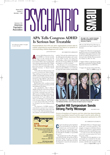APA Trustee-at-Large David Fassler, M.D., a child and adolescent psychiatrist in private practice in Burlington, Vt., cited the results of two studies to prove a point when he testified about attention deficit/hyperactivity disorder (ADHD) and its treatment on Capitol Hill last month (see
page 1).
“These studies underscore the importance of obtaining a careful and comprehensive evaluation, and that was one of the messages we were trying to convey,” Fassler told Psychiatric News.
His testimony during a hearing by the House Committee on Government Reform, which looked at the prevalence of ADHD and questions surrounding the prescription of stimulant medications, emphasized that “there is no evidence of widespread overtreatment with medication.” In contrast, he testified, the studies indicate that there are areas of the country where the majority of children with ADHD are not receiving appropriate and effective treatment.
“The findings from these studies are consistent with previous reports suggesting that overdiagnosis and/or overtreatment of ADHD is not a widespread phenomenon,” Fassler told Psychiatric News. “This certainly doesn’t mean that it does not occur or is not a problem in specific communities. However, the current literature suggests that we have a much larger problem with underdiagnosis and undertreatment.”
Few Children Treated
Fassler said the two studies were particularly useful because each had a unique point of view.
The first study he cited in his testimony was by Peter Jensen, M.D., now Ruane Professor of Child Psychiatry in the Center for the Advancement of Children’s Mental Health at Columbia University. The study appeared in the July 1999 issue of the Journal of the American Academy of Child and Adolescent Psychiatry and looked at the diagnosis and treatment of ADHD in four communities across the country.
Jensen and his colleagues assessed 1,285 children in Atlanta, New Haven, Conn., Westchester County, N.Y., and San Juan, P.R. The communities were selected because of their demographic diversity.
Jensen found rates of ADHD to be quite variable, ranging from a low of 1.6 percent in San Juan to a high of 9.4 percent in Atlanta; 5.1 percent of all the children met DSM-III-R criteria for ADHD. Interestingly, Fassler said, only 12.1 percent of those children had been treated with stimulant medications. In contrast, out of the 1,285 children who were prescribed stimulant medications, Jensen found only eight who did not meet diagnostic criteria; however, these children did show significant (but subthreshold) symptoms of the disorder.
Similar Results Obtained
The second study Fassler cited is believed to be the first of its kind, and its results may significantly alter the way the mental health field looks at ADHD and the use of psychostimulant medications.
The study, by Mayo Clinic researchers, followed all children who were born (just over 5,700) between 1976 and 1982 in Rochester, Minn., and continued to live in the area after age 5. The report of the study appeared in the March Archives of Pediatrics and Adolescent Medicine.
The study team, led by William J. Barbaresi, M.D., an assistant professor of pediatrics and adolescent medicine at Mayo Medical School in Rochester, had unusually broad access to both medical and school records and were able to review all of the records for each child to identify clinical diagnoses of ADHD. They also had access to supportive documentation that could indicate symptoms that fulfill DSM-IV criteria or positive results from an ADHD-related questionnaire.
The researchers split the cohort into four subpopulations: those identified as “definite ADHD”—having a clinical diagnosis and at least one of the two types of supportive documentation; those identified as “probable ADHD”—having a clinical diagnosis but no supportive documentation, or no clinical diagnosis but both types of supportive documentation; those having “questionable ADHD,” with no clinical diagnosis, but at least one type of supportive documentation; and a subpopulation of “not ADHD” individuals, comprising all other subjects.
The highest estimate the authors calculated for the cumulative incidence of ADHD at age 19 was 16 percent. That figure included the “definite” plus the “probable” plus the “questionable” subpopulations. The lowest estimate, comprising only the “definite” group, was 7.4 percent.
Interestingly, in the group identified as having definite ADHD, 86.5 percent had been prescribed stimulant medication as treatment; in the group having probable ADHD, 40 percent were prescribed a stimulant; and 6.6 percent of those with questionable ADHD had received a prescription for a stimulant. Of those who were identified as “not ADHD,” 0.2 percent had received a prescription for a stimulant medication.
“Once again,” Fassler testified, “this very carefully conducted study simply doesn’t support the argument that ADHD is generally overdiagnosed or overtreated. In fact, as the authors point out, even in a community with excellent access to medical care, one child in five with ADHD was receiving no treatment with medication.”
An abstract of “Are Stimulants Overprescribed? Treatment of ADHD in Four U.S. Communities” can be accessed on the Web at www.jaacap.com by clicking on “Contents” and then on the July 1999 issue. An abstract of “How Common Is Attention-Deficit/Hyperactivity Disorder? Incidence in a Population-Based Birth Cohort in Rochester, Minn.” is posted at http://archpedi.ama-assn.org/issues/v156n3/abs/poa10326.html. ▪
Arch Pediatr Adolesc Med 2002 156 217
